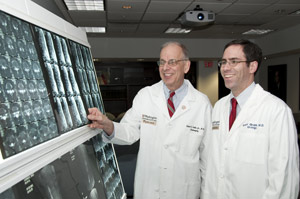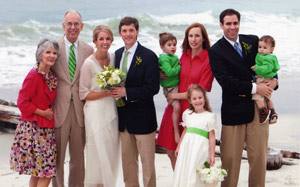Robert L. Grubb Jr., M.D., professor emeritus of neurosurgery, kept a difficult and important resolution last year. Grubb had decided to lay down his scalpel when he turned 68, and that’s exactly what he did in July 2008.

“I was still doing fine in the operating room, but I had kind of pulled 68 out of the air years ago and decided to quit then while I was still ahead,” he says and then chuckles. “If I’d only known what the stock market crash of 2008 was going to do to my retirement accounts three months later, I never would’ve stopped!”
Grubb laughs at his own expense often, and the target of his humor is frequently his age or his four-and-a-half decades of service. A moment after pointing out his portrait in the Department of Neurosurgery’s conference room, he says, “Nearly everyone with a portrait up here is dead. What does that say about me?”
The real punch line to these jokes, though, is that they seem to be the product of an extraordinary degree of comfort with his change of status. Far from being “one foot in the grave,” as he jokes at another point, or otherwise on his way out, Grubb continues to be an active member of the University community, seeing outpatients in clinics three days a week, serving as the principal neurosurgical investigator on a major multicenter clinical trial and working on a history of the Department of Neurosurgery in honor of its upcoming centennial in 2011.
Making up his mind
Grubb came to Washington University in 1965 from his home state of North Carolina, where he went to medical school at the University of North Carolina at Chapel Hill.
“The surgery chairman at Chapel Hill at the time was a fellow named Nathan Womack,” says Grubb, who reels off decades-gone histories of colleagues, mentors and institutions. “Womack was one of the first general surgery residents at Washington University under Evarts Graham, M.D., chairman of the department of surgery from 1919-1951.”
Womack suggested Grubb consider Washington University School of Medicine as a place to serve his internship in general surgery before choosing a surgical specialty. After investigating, Grubb moved to St. Louis with his wife and high-school sweetheart, Julia. A year into his residency in general surgery, though, he was drafted and sent to Vietnam in 1967.

“I was weighing my options for surgical specialties and wasn’t quite sure which one I wanted to pick,” he says. “Suddenly, I was told I was going to end up in Vietnam, and I decided I’d better make up my mind real quick.”
Grubb found an opening for a residency in neurosurgery beginning in 1969. After spending a year in South Vietnam at a civilian hospital in the town of Nha Trang, he spent his second year in the service at the National Institutes of Health and returned to the University, completing his neurosurgery residency in 1973.
As a resident, he worked in the laboratory of Michel Ter-Pogossian, Ph.D., a early developer of positron emission tomography (PET) scans. His colleagues in the lab included another new arrival, Marcus Raichle, M.D., now professor of neurology, of radiology and of neurobiology. Forty years later, the two still are close friends.
“The chief of neurosurgery at that time was a man named Henry Schwartz, a legendary figure in the field, and nobody can tell stories about him quite like Bob Grubb can,” Raichle says. “His ability to share his interest in the history of his field is quite impressive.”
During their time in Ter-Pogossian’s lab, both scientists worked to develop PET to monitor blood flow dynamics in the brain. They’re both still doing research in this area, although in different contexts and using different techniques.
Blood and the brain
As a surgeon, Grubb developed three subspecialties: acoustic neuromas and other tumors found at the base of the skull; carotid endarterectomies, procedures that clean out blocked or partially occluded carotid arteries to reduce the risk of stroke; and surgical procedures to relieve trigeminal neuralgia, a painful condition involving the nerves of the face.
In the laboratory, Grubb studies how issues relating to brain blood flow, including atherosclerotic blockages of the carotid arteries, affect stroke risk. He began collaborating with William Powers, M.D., chair of neurology at the University of North Carolina at Chapel Hill, on some of these issues in the early 1980s.
Powers is principal investigator and Grubb is principal neurosurgical investigator on a multicenter trial to see if a procedure known as an extracranial/intracranial arterial bypass can decrease stroke risk in patients with reduced blood flow in the brain due to an occluded carotid artery. The procedure connects an artery in the scalp to an artery on the surface of the brain to improve blood flow.
“This operation was widely used in the 1970s and 1980s, but then results of a multicenter trial were published in 1985 that didn’t show any benefit of the surgical procedure in preventing stroke over nonsurgical treatments,” Grubb says. “The operation kind of died out after that.”
Grubb and Powers are concerned, though, that the multicenter trial failed to test the bypass operation in the patients most likely to benefit from it.
“The brain has a lot of arterial connections, and that means that some people can still have good brain blood flow even when one of their carotid arteries become partially or fully blocked,” he says. “The 1985 trial didn’t screen for this — they just applied it in anyone who’d had a stroke with partial or complete blockage of the carotid.”
|
Robert L. Grubb Jr. |
|
Born in: Charlotte, N.C. Lives in: Glendale, Mo. Family: Wife, Julia; son, Robert, 39; daughter, Mary Connell Lifton, 34 Favorite vacation spots include: Pawleys Island, S.C. High point of being a sports fan: Watching the North Carolina Tar Heels win the NCAA basketball championship in St. Louis in 2005 Low point of being a sports fan: Watching the St. Louis Cardinals football team lose its last game in St. Louis in 1987 |
In a study conducted by Grubb and Powers in the 1990s, poor blood flow in the portion of the brain normally supplied by the blocked carotid artery was associated with an increased risk of stroke. In the new trial, researchers are screening patients with PET scans to measure brain blood flow and only entering subjects with reduced blood flow into the study to maximize patients’ chances of benefitting from the procedure.
“Bob is applying in patients what he and I helped lay the groundwork for decades ago in basic PET research,” Raichle says. “It’s clinically meaningful translational research.”
Making history
Grubb recently completed a first draft of a history of the Department of Neurosurgery.
“It needs a lot of editing and is not likely to be a bestseller,” he jokes.
The narrative, assembled from documents, anecdotes and personal histories Grubb pulled together in the department and from the medical school archives, covers the period from the 1911 arrival of Ernest Sachs, M.D., the first person in the world to train specifically in neurosurgery, to the retirement of Sidney Goldring, M.D., as neurosurgery chairman in 1989.
“Dr. Ralph Dacey, our current department head, told me to end it with the start of his term because that’s a history that has yet to be written,” he says. “One of the most remarkable things about this department’s first century is that it’s had only four leaders in all that time.”
Grubb says he’s “not really a historian,” but he enjoys the subject. He is disappointed that previous attempts to write the history of the School of Medicine and Barnes Hospital in the late 1940s and ’50s never were completed.
The interest in history runs deep in the Grubb family. Robert Grubb Jr.’s son, Robert L. Grubb III, M.D., assistant professor of surgery in the Division of Urological Surgery, majored in history before going to medical school.
Ralph G. Dacey, M.D., the Henry G. and Edith R. Schwartz Professor and head of Neurological Surgery, is grateful for Grubb’s work.
“Dr. Grubb has done a great service to the department by compiling our history, but his impact in making our department great through his efforts as a scientist, surgeon and teacher over the past 40 years have been even more notable,” Dacey says.
“He is a great colleague and citizen of Washington University,” Dacey says.
One of the copies of Grubb’s first draft of the history went straight to his old friend Raichle.
“To care about this aspect of the work we do is important,” Raichle says. “Sometimes we get caught up in the moment of our own successes, not remembering how dependent they are on the work of those that preceded us. For someone to take charge of reminding us of that is certainly to be admired.”